Main Themes.
This year apart from the flood of releases from TomTom, the big thing was integrated personal navigation devices. A lot of these systems seem to be based around a Windows CE .net platform and most come with a built in media player. Unfortunately most of these are being packaged without access to the underlying operating system preventing you from installing additional software. We have already seen a number of these hit the streets this year, but it looks like many more will soon follow. Manufacturers with new PNDs on display included Fortuna, SysOnChip, GlobalSat and LeadTek.
The other new trend seems to be mobile PCs. Again there were a number of companies displaying car radio sized computers, most of which had pop out screens. This of course means that you can have your favourite PC navigation software running and if you include WiFi you can download your email whilst in the Drive Thru at McDonalds, or in the car park outside the local Starbucks. This will really make a difference to off-roading with Topo products like Anquet, Fugawi, or Memory-Map. You can tell that this is now a mainstream as NavMan had one on their display.
All the “usual suspects” were there and also a few we had not seen before and we were able to make their acquaintance. NavMan, Garmin, Destinator, Co-Pilot, Navigon, Route 66, Wayfinder, and the newer entries into the market such as Navicore were all represented.
The two major mapping companies were there. NavTeq had their own stand which was host to a number of their navigation software partners. Whilst TeleAtlas took the other stance and had their staff present on the Navigation software companies stands.
The GPS hardware companies were spread around the halls a little and we had to search them out a bit. We did manage to find Holux, SysOnChip, RoyalTec, GlobalSat, Rikaline, Mitac/Mio and Fortuna, but did not find Leadtek (turns out they were in hall 23 with the PC components). Lutz had a quick look at some of the PDA devices on offer from HP and also from Fujistsu.
Let’s not forget the accessory companies. The mounting providers were there in force with Brodit, CarComm, Elan and Herbert Richter, plus many other smaller companies offering all manner of add-ons for your PDAs and navigation devices.
One of the more interesting parts of CeBIT is wandering around the Far Eastern exhibits. Here we find a lot of weird and wonderful devices, from TomTom look-alikes to dedicated Navigation systems that looked like oversized PDAs.
The final and possibly most interesting stand for our younger readers was the Gizmondo stand. Gizmondo are another company with a big budget. The Gizmondo device will be launched on Saturday 19th March in London.
Enough of my ramblings let’s get to the interesting bits: the companies and their latest releases and offerings:
|
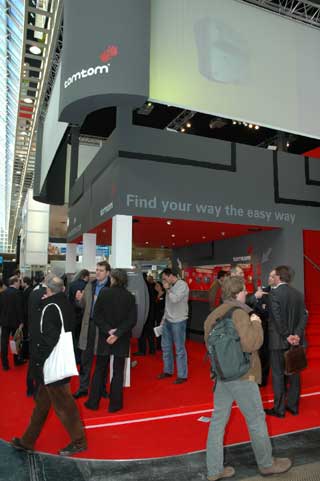
TomTom stand during a quiet spell.
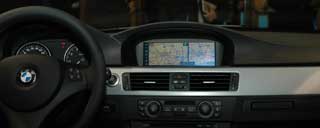
BMW Connected or totally wired?
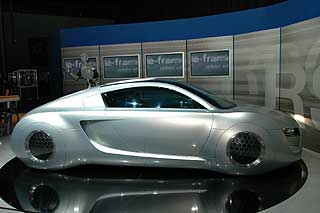
I-Robot. I want one of these cars!
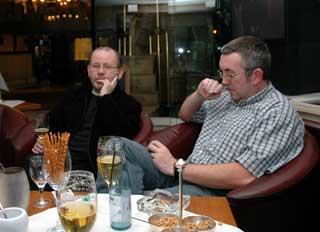
Preparing for Day 1 checking the Fair Planner |
|
TomTom
As I mentioned above TomTom’s stand was positioned right in the middle of the GPS hall, dominating the surrounding areas. Although there was a very well publicised leak regarding the new TomTom GO hardware TomTom still managed to surprise us with quite a few new products even those of us who have been in the TomTom Navigator beta test program were not privy to all the new releases.
First and foremost was the release of the new TomTom GO hardware. There are three new devices all of which have Bluetooth and will communicate with a mobile phone. The top two models also feature hands free mobile phone operation. The TomTom GO 700 flagship model no longer has a SD card slot as this has been replaced by an internal hard disk drive. The good news is that the new TomTom GO 5 software will work on existing GO devices.
Next up was the TomTom Rider, a navigation device designed specifically for motor cyclists. This is a waterproof version of the GO with a new mounting system for the handlebars, and it is missing the speaker on the back. This makes it a device with much more of a traditional rectangular casing. The speaker has been replaced with a Bluetooth audio headset. The TomTom Rider runs the same software as the GO.
Last month at 3GSM in Cannes the latest TomTom Mobile 5 software was announced. It therefore came as no surprise that the same software was announced for all the other TomTom Navigator platforms, especially as we had been beta testing it for over a month. What was a surprise though were the TomTom Plus services. There were parts of the beta software that we didn’t have access to. Having seen the new GO hardware and TomTom Plus service it all falls into place now.
TomTom Plus is a range of online services which allow you to extend the functionality of the Navigator software with Traffic, Weather, downloadable maps etc.
We had a couple of sessions with Pieter Geelen one of TomTom’s founders and other TomTom directors. During our chat Darren and Lutz questioned Pieter whilst I examined the new GO 700 and started dismantling it. A look of horror crossed Pieter’s face when he saw what I had done, but I did manage to put it back together again.
Even better it was still working. Sorry no photos allowed. Well OK, just the one, but don't tell anyone where you saw it! |
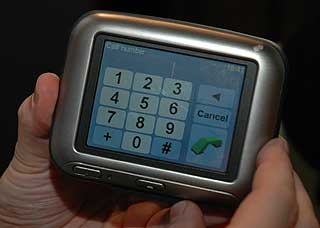
TomTom GO 700 notice the lack of SD cards
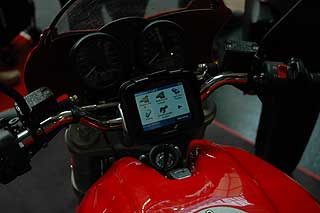
TomTom Rider
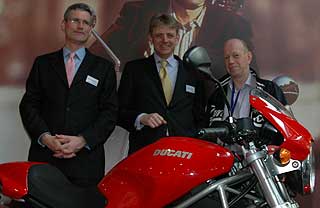
Alexander Ribbink, Harold Goddjin, and Mike
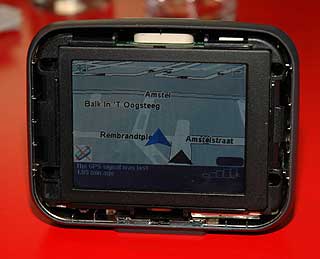
Oops I broke it! |
|
Navman
The NavMan stand was split into two sections: Street Navigation and Sport-Tool.
The Street Navigation had on show the now familiar SmartST navigation software running on a number of PiN devices including the new PiN570. The PiN570 was launched at the exhibition and is a combination PDA/Navigation System. This PDA has a nice style to it and is fully compatible with other Windows Mobile applications. As this year progresses we are starting to see more an more devices that are locked to navigation only. Fortunately the PiN570 is not one of these. Well done NavMan for keeping the system open. A big plus point for the PiN570 is that the SmartST application is built into the PDAs ROM. No more reloading applications when you hard reset!
The Sport-Tool side of the NavMan stand features the new personal fitness and training GPS products. There are a range of 5 devices designed specifically for different disciplines: Running, Walking, Skiing, Skating and Water sports. The different models record different time/distance measurements. This is of little use to the navigation users as there is no GPS logging or data connectivity on offer. This is an example of GPS encroaching on traditional multifunctional timers with additional features.
The final item of interest on the NavMan stand is a look at a possible future. Tucked away in the corner away from the eyes of the public side of the stand was what looked like a PC. This was of course not an ordinary PC it was a DIN sized PC for replacing your car radio with a computer. This also had a motorised flip up LCD monitor of about 7inches. This was running a version of SmartST and looked like it might have a touch screen. This is all speculation of course as NavMan would not comment on it!
|
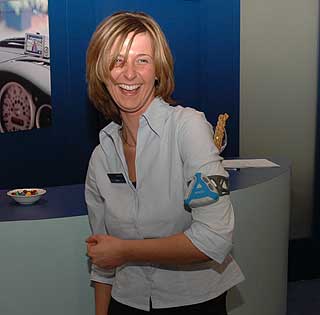
Something sporty from NavMan...
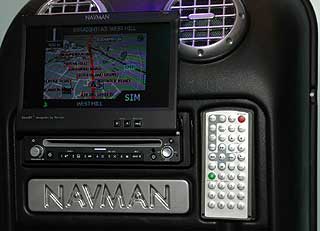
We cant tell you about this!! |
|
Destinator
Destinator were there in two areas this year. The were present on the NavTeq stand and also in one of the Microsoft Business halls.
Whilst we were at the NavTeq stand we were invited upstairs for a chat with Andreas Erwig (European Marketing Manager) and Saar Avigour (Director Product Development) we also saw some of the guys we met from Homeland Security Technology whilst we were in Toronto.
Destinator are revamping their product range to drop their current terminology for Destinator on different hardware platforms. The line up will be:
- SP - Smart Phone
- PN - PDAs
- ND - Navigation device
Destinator SP is available now, the other two will be released in May.
Destinator are also to introduce an new LE product. this will have reduced functionality ie only a 2D map view. The maps provided will be for a single city, and the product will sell for €20 about £16.
Destinator are also introducing cross border navigation on the Navigation Device version (Mio 269) which will have 2Gb of map data for Europe.
Destinator will also be able to seamlessly use the most detailed map for the areas you have loaded, so to travel to Italy from the UK you would install the UK map, the Italy man and the major roads of Europe, Destinator will then route using a combination of the maps. |
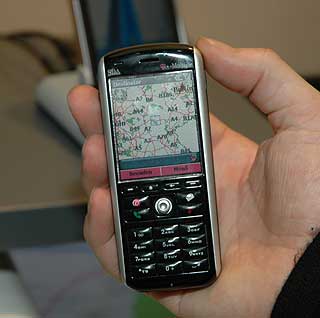
Destinator SP
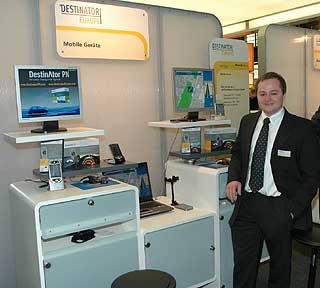
The Destinator Professional stand |
|
Co-Pilot
There was nothing new on the Co-Pilot stand. Dan Popkin and David Quinn were part of the exhibition team, which had the latest Co-Pilot Live software on display.
The one piece of news that did slip past the media recently is that ALK have partnered with T-Mobile in the UK to bundle Co-Pilot with T-Mobile.
They were also demonstrating Co-Pilot running on the new Motorola Linux based mobile phone. |
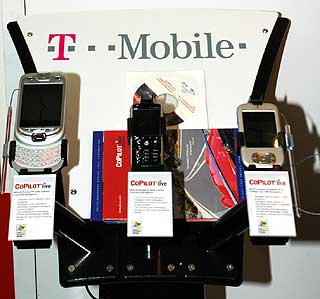
Co-Pilot and T-Mobile partnership |
|
| Alturion
Alturion were demonstrating their GPS Navigation product. Despite being a small company their products show a commitment to quality and have features that many of their competitors lack. We were shown some of these including the ability for users to report road long-term closures and POI corrections direct to Alturion from the PC Application.
Features such as dynamic weather overlays as well as TMC Traffic data are present and the products come with PC and PDA applications as standard. Alturion stand out as being the only solution that offers map regular updates on a subscription basis. |

Sean from EasyDevices with Lutz and Darren on the Alturion stand. |
|
Navicore
Navicore are a Finnish company who already have an established GPS Navigation solution for the Symbian Series 60 and 80 platforms in Scandinavia. They are shortly releasing a UK version of the software and were good enough to give us a detailed demonstration of the product.
Not only does it look very slick indeed but the interface is revolutionary and works well given the limited real estate and input options of a phone. The maps are a model of clarity and this looks set to do very well when it arrives in the UK. |
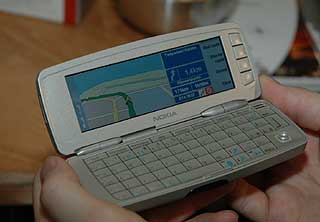
Navicore on the Nokia. Lovely screen! |
|
TeleAtlas
Our first meeting at CeBIT was with Laurent De Hauvere from TeleAtlas. We were scheduled to meet for 30 minutes and ended up talking for nearly an hour.
The salient points of our discussions were:
TeleAtlas currently release 2 map sets a year. Typically in March and October. If you see maps being referred to as 2004-2 this means the second release. There will occasionally be interim releases, but these will not add new roads, just correct the attributes of existing roads.
TeleAtlas provide mapping for TomTom, NavMan, Navigon, Via Michelin and others.
Recently TeleAtlas bought GDT in America and are currently working on merging the two databases to improve the quality and coverage of their product. This should give them 5,000,000 Km of additional roads.
We also talked about their mobile "Navi Vans" these have 3D cameras and record all manner of information, improving the speed of a survey by a multiple of 5.
We asked Laurent about the accuracy of the POI database, he said that they were working with strategic partners and would significantly improve the accuracy in the 2005-2 release.
TeleAtlas are also extending the coverage of their mapping to include "connector network" in Eastern Europe which will include Russia, Poland, Hungary etc. They are also creating strategic partnerships to be able to deliver map data for Asia, including Australia, China, Hong Kong and Singapore.
|
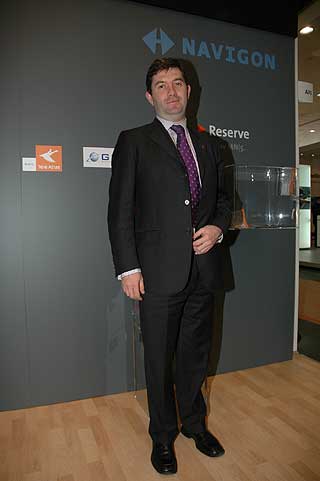
Laurent from TeleAtlas on the Navigon Stand |
|
Gizmondo
Gizmondo may be the next “big thing”. The Gizmondo is going to be launched on 19 th March in London. This integrates a gaming machine with a GPS receiver, with GSM/GPRS and SMS. The only thing missing is a mobile phone, but who wants to talk anyway?
The Gizmondo is being marketed very much as a revolutionary gamming system, but it is so much more. We managed to distract the Gizmondo marketing executive long enough to have a play with the device and see what it can do. When TomTom announced the inclusion of the Gizmondo on their compatibility lists we had to see for ourselves. The pictures to the right say all that needs to be said.
The Gizmondo could really go places. I am honestly not distracted by the lovely blonde ladies, this is the device that could start a completely new genre of gaming with crossover into other areas as well.
Gizmondo are already planning a version for the business community with integrated access to the Internet and shares trading. Watch out for the Bizmondo coming soon to a pocket near you!!
I would like to point out that while I was being entertained by a bevy of beautiful girls, Lutz totally ignored them and had a good play with the Gizmondo. Who has got it right? |
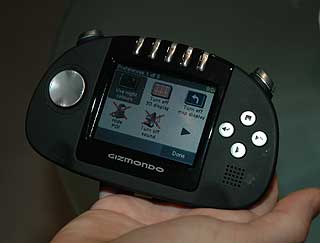
Now where have I seen this software before?
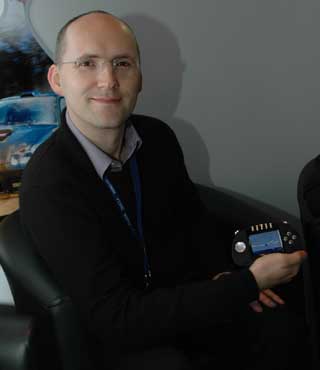
Lutz playing with TomTom on the Gizmondo |
|
Mio
Mio had the 168,268 and 269 PND devices on display. There was nothing new on the stand, which I suppose is not surprising as they have only recently launched the 268 and 269.
The Mio Digiwalker 268 and 269 devices are GPS enabled PDAs which run a version of Navigon on the Windows CE.Net operating system. In common with a lot of the new PNDs these devices run with a locked operating system so you cannot put new software on the device. |

Mike and Lutz on the Mio Stand. |
|
Fortuna
The Fortuna was interesting. They had 3 new products on display: a new SiRF Star III Bluetooth GPS and 2 Personal Navigation Devices.
The new Fortuna Slim Bluetooth GPS uses the latest SiRF Star III chipset and has Xtrac (I assume 2) built in. By default it is WAAS/EGNOS enabled so where DGPS is available your position will be corrected. The GPS comes with a replaceable 1200ma Lithium battery which it is claimed is good for 8.5 hours.
The Fortuna NView GPS-100 PND is an all in one device which is packaged in the size of a normal PDA. The version we saw had an internal integral antenna making it look similar to an XDAII. That is where the similarities end though. The GPS-100 includes the SiRF Star III chipset. This has a QVGA touch screen and 64Mb of memory. This is also the first device to have 2 SD expansion slots allowing for up to 4GB of external storage. The device that we saw was running the PrymeNav navigation software, but it was not clear which application it would be shipped with. The whole package is built on top of a Windows CE .net architecture and it is our belief that the platform would be supplied unlocked allowing additional applications to be added.
The final Fortuna addition was the NView GPS-2000. This is very much a dedicated in-car navigation system. The screen is a massive 7inch TFT LCD touch screen monitor running at 800x480. As with the GPS-100 the PND sports a SiRF Star III GPS, but this time also has either a 20Gb or 40Gb hard drive in it. Options allow you to add a TV/Radio tuner. Again this was running a version of PrymeNav navigation software. |
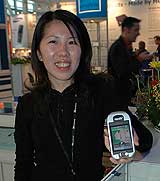
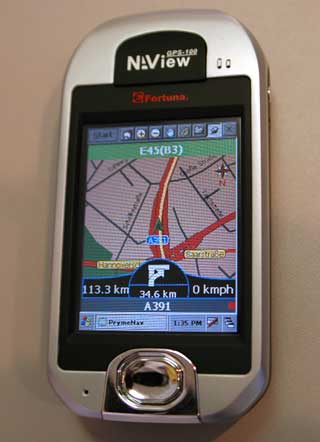
The new Fortuna GPS100 |
|
RoyalTek
The RoyalTek stand also sported a number of new machines. They had a PND based on Windows Mobile 2003, a number of different Bluetooth GPS devices and also a wrist watch sized GPS. Unfortunately we had a communications breakdown on the RoyalTek stand as there was no-one around who spoke English so all of the following is either assumed or gleaned from their brochure.
The PND PDA is the RoyalTek RTW-100. This is a WM2003 PDA with a 266MHz processor, 64Mb Ram, and a QVGA 240x320 touch screen display. It has an internal GPS receiver, but there are no details available of the specification. It also supports SD for additional storage interestingly there is a caveat in the brochure “License fee for SDIO controller not included”. There was no indication if this was to be a PDA in its own right or part of a complete navigation package.
RoyalTek had a range of new Bluetooth receivers called the RBT-2001. There was no specification for these. Essentially they looked like coloured versions of the RBT-1000, but the new model number suggests that they may have a later chipset.
A new wrist watch style of GPS was on show, and Lutz was drawn like a magnet to it. It is a bit chunky for a watch, but it a reasonable 1.4inch LCD screen, and also a mini USB communications port to enable connection to a PDA or PC.
There was a GPS device that we didn’t see, but was in the catalogue: the RTG-1000. This is Bluetooth GPS receiver that also has a TMC receiver incorporated.
Again it is difficult to comment further as none of us actually saw it and understood what it was at the time. Fortunately our friend Guillaume from www.gpspassion.com was in CeBIT today and he sent us this picture. |
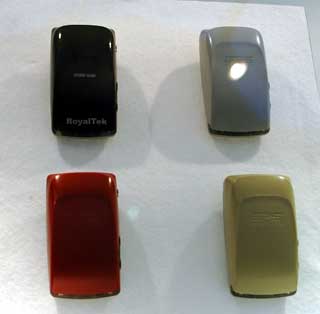
The RoyalTek RBT-2001 range
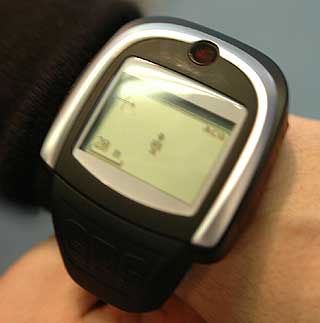
The RoyalTek Wrist GPS
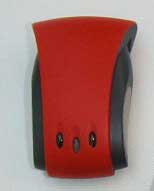
The RTG-1000: Thanks Guillaume! |
|
Holux
Holux also had a host of new devices. This included a handheld GPS, a GPS Tracker, new Bluetooth receiver, a PND and a wired GPS.
The GM-308 is a colour handheld GPS device that sports a USB interface to a PC with a 2.7 inch screen. The spec sheet for it boasts of voice navigation and advanced routing capability, but we didn’t see that in action. We will have to wait for it to be released for more details of operating firmware and its real capabilities.
The GR-500 is a handheld GPS tracking device based around the SiRF Star III and Siemens GSM/GPRS chipsets. They are claiming to implement a 20 channel receiver for fast TTFFs. Sized at 88.5x45x22mm it is a little smaller than a mobile phone. The GPS tracker also outputs a serial NMEA data feed so you can connect to a PC or PDA.
The GR-236 is a “Small Size Bluetooth GPS Receiver”. This appears to be a dual function Bluetooth or Serial Mouse type GPS receiver. As with most of the new GPS receivers it has the SiRF Star III chipset at its heart with a separate 1000MAh battery. Not sure if this is WAAS/EGNOS compatible. Again the details are a little sketchy so don’t rely on this.
The GR-213 is a mouse GPS SiRF Star III again, with WAAS/EGNOS support. This time the interface supported is serial RS232 only.
The final Holux product on show was the NAV-51. This is a Windows CE .Net based Personal Navigation Device. It sports a 200MHz processor with 32Mb of RAM. The screen is a 3.5inch TFT LCD QVGA display. The integrated GPS is based around (yes you have guessed it) SiRF Star III chipset, with a flip up antenna. Interestingly this is not supplied with any navigation software so Windows CE.Net software will need to be sourced. A number of companies have Navigation software working on this platform, but I am not aware of any that sell it software only at the moment.
|
|
Sheng Jay Automation Technologies
Normally I wouldn’t report on a Taiwanese company that nobody had ever heard of except for two things: first I wanted an excuse to show the new pocket sized PDA, and secondly they are producing a range of battery powered GPS car mounts.
The PDA is really a 7inch touch screen with 800x480 resolution Personal Navigation Device. It is powered by an internal battery and has a 400MHz Intel PXA255 processor at its core and a SiRF Star II (not 3) GPS receiver built in. It runs an unlocked version of Windows CE.Net 4.2 and has options for on-board WiFi and GPRS. So all in all it is a well specified device.
The GPS Car holders come with a gooseneck windscreen suction mount. These have an onboard GPS receiver and connect to the PDA via the ActiveSync port. It is not clear which chipset is being used, but you might assume SiRF Star II as with the PND. A uniqueness about this mount is that is contains a battery which should keep the GPS running when the power from the car has been removed.
|
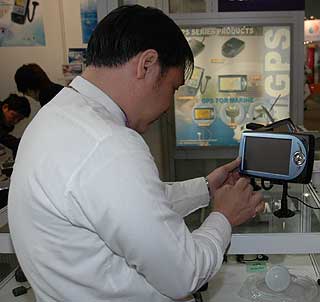
Honey the PDA has got bigger! |
|
SysOnChip
The SysOnChip stand had a lot of new items, focusing purely on the GPS devices we say a range of CF Memory GPS receivers, up to 1GB capacity. They also have a new Bluetooth GPS called the “Smart Blue” which is a tiny GPS receiver barely bigger than it’s replaceable battery. And 2 new devices under the brand of Looket.
We currently have the CF Memory GPS in review at the moment and this gave me the opportunity to question SysOnChip about the sensitivity issues I have been experiencing. More of which will follow in the review. The interesting development here is the inclusion of a 1GB CF card. Plenty of room for the maps of Europe.
The Smart Blue is a tiny Bluetooth receiver which is based around either the SiRF Star IIe/LP chipset or the Antaris chipset. With the rechargeable battery the receiver can run for 10 or 12 hours dependant on the chipset. The amazing thing about this receiver is the miniscule size of it. If you imagine a mobile phone battery the receiver is just a little wider and longer and just over twice as deep.
On to the Lookets then. SysOnChip are producing a Multimedia player and a Personal Navigation device. The Multimedia player (Looket P20) is based round a 20Gb hard drive. This is capable of storing and playing Movies, Audio, and Pictures. The interface allows devices like digital cameras to be connected directly and the images downloaded into the device. The multimedia player has a 3.5 inch QVGA LCD display, which was absolutely stunning.
The Looket G7 is a Windows CE.Net 4.2 based navigation system. It is based around a Samsung 400MHz processor and has the same 3.5inch screen as the P20. This appears to be a device that will be offered in an unlocked format with undetermined navigation software supplied. The specification of the GPS chipset is not known. The G7 will of course work as a media player as well, but without the benefit of the hard disk drive.
|
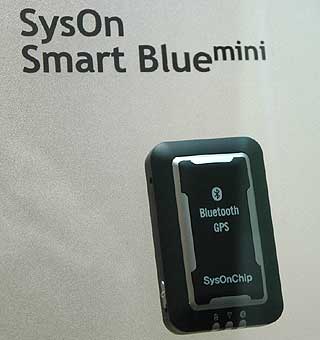
Not much bigger than a phone battery Smart Blue
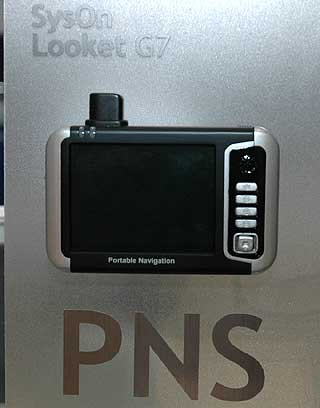
The SysOnChip Looket G7 Navigation Device |
|
GlobalSat
GlobalSat as usual had a tantalising display. The new BT-338 was on show, and I actually sent my review sample back for a firmware upgrade. They also had a new SDIO GPS receiver, a GPS enabled PDA holder, and yes you’ve guessed it a new Personal Navigation Device.
The GPS PDA holder is supplied with a gooseneck windscreen mount and is compatible with a range of PDAs via an interchangeable connector. The antenna for the holder flips out and can be adjusted for optimal signal reception. The whole lot is held in place with retractable wings. The GPS chipset for the holder was not specified.
The BT-338 is a Bluetooth GPS device featuring the SiRF Star III chipset. I was given on of the first production devices to test. This is now back at Globalsat for a firmware upgrade. From the results of my tests the signal strength and quality was excellent, and should be even better with the new firmware.
We know very little about the SDIO GPS and the PND as there was no technical details available and they were locked away in a glass cabinet. We have the pictures for you though. The SDIO GPS does have memory on board so will be of more use to a wider range of PDA users. |
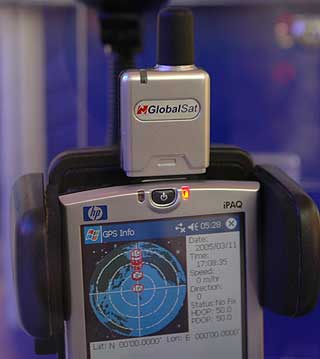
Globalsat SDIO GPS with Memory
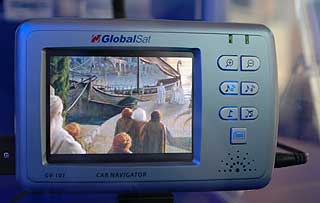
|
|
| GNS GNS are a leading developer and supplier of TMC (Traffic Message Channel) GPS Receivers and provide TMC receivers for Navigon and Alturion's traffic enabled navigation products.
GNS announced two new products at CeBIT, the first, the GNS 5840 Bluetooth GPS receiver combines Bluetooth GPS with TMC and utilises a 12 channel SiRF Star II/LP chip. With a 1700mAh battery the unit will operate for more than 10 hours on a single charge.
The second product is the GNS FM9 which is something of an oddity; it is a 12v PDA charger cable that contains an integrated FM TMC receiver. GNS displayed this connected to a PocketPC running custom TMC decoding software that displayed the traffic events. |

The GNS Bluetooth GPS/TMC receiver |
|
ATP
We accidentally stumbled on to the ATP stand, it was in the middle of the Taiwan area where GlobalSat and RoyalTek had their exhibits.
At ATP Danny Lin, the Vice President, took us into his cubicle and magically produced an amazing array of memory cards. Some of the most interesting are pictured to the right.
One of the surprising things was the odd sizes that they were producing, 384Mb 768Mb, 1.54Gb, but the stat of the show was the 2GB SD card. And yet it does work fine in my 4700, but Danny insisted on having it back.
Another surprise is the resurgence of the MMC card. These are matching the SD card in sizes and will soon have a new standard. |
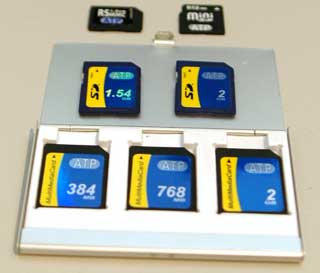
The ATP memory bank |
|
Brodit
The Brodit stand was located in the main GPS hall 11. As they tend to release new product on a regular basis throughout the year there was very little that we had not already reported on. The main new item was a new Move-It style mount constructed for heavy duty loads. |
|
| CarComm The Carcomm stand revealed that they have not been resting on their laurels over the previous 12 months. They have instead been very busy developing many new products and had a range of new cradles and accessories on show. Of most interest will be a range of new cradles to fit popular PDA's such as HP's h6300 PocketPC Phone Edition and the MDAIII.
Carcomm also had Smartphone Car kit cradles that offer full duplex phone functionality for the C500 as well as a PDA Sound amplifier accessory. |
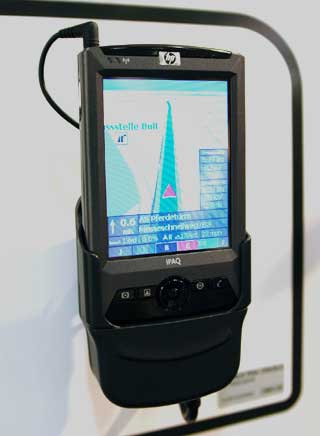
New CarComm mounts |
|
Elan
Elan are a new venture in the UK closely affiliated to Nemesis. Elan produce a range of hands free car kits which once fitted allow you to change your phone, without having to change the car kit.
This works by having a phone cradle and a mount connected via a bespoke plug/socket. When a new phone comes on the market, all you need to do is replace the cradle and you have a hands free car kit.
This works really well for people like me as my wife and I both have different phones, all we need is the Elan system and 2 cradles. |
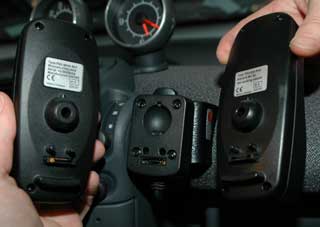
Lets play Switch-O-Roo! |
|
Herbert Richter
Herbert Richter may or may not be known to many of you. They are the manufacturers of a wide range of car accessories including the vast majority of in-car PDA mounts that exist today and are also responsible for the GO car mount. Their 4-finger cradle clip design is becoming the de facto standard today and their cradles, gooseneck mounts and other systems have been bought by nearly every GPS manufacturer. If your mount or holder has "Made in Germany" on it you know where it has come from.
Announced at the show is a new modular universal mount system that provides sound amplification, optional built-in or mouse type GPS connections and power coupled with a custom cradle. The mount, central connections box and cradle are all separate and can be combined in many ways. When you change PDA all you need is a new cradle part. We have one in for review and first impressions are superb. |
|
Time to go home
Finally our visit to Hannover came to an early conclusion late Friday afternoon when we had to leave a meeting with Harald Richter to rush to the airport to fly home. We had visited most of the people we wanted to see, but there were so many more and all the other gadgets… We will have to stay longer next year.
On our flight back we met Harold and Corinne from TomTom, who were seated just behind us. I had an interesting chat with them and hopefully we will be arranging a visit to both their London and Amsterdam offices in the near future. |